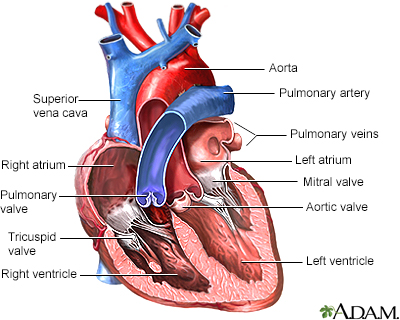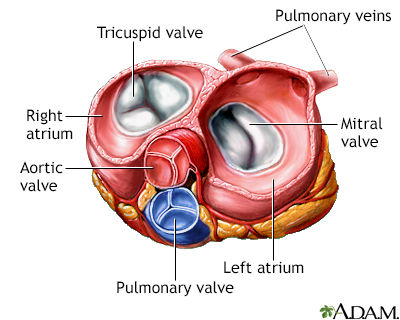Takayasu arteritis
Pulseless disease, Large-vessel vasculitis
Takayasu arteritis is an inflammation of large arteries such as the aorta and its major branches. The aorta is the artery that carries blood from the heart to the rest of the body.
Images



I Would Like to Learn About:
Causes
The cause of Takayasu arteritis is not known. The disease occurs mainly in children and women between the ages of 20 to 40. It is more common in people of East Asian, Indian or Mexican descent. However, it is now being seen more often in other parts of the world. Several genes that increase the chance of having this problem were recently found.
Takayasu arteritis appears to be an autoimmune condition. This means the body's immune system mistakenly attacks healthy tissue in the blood vessel wall. The condition may also involve other organ systems.
This condition has many features that are similar to giant cell arteritis or temporal arteritis in older people.
Symptoms
Symptoms may include:
- Arm weakness or pain with use
- Chest pain
- Dizziness
- Fatigue
- Fever
- Lightheadedness
- Muscle or joint pain
- Skin rash
- Night sweats
- Vision changes
- Weight loss
- Decreased radial pulses (at the wrist)
- Difference in blood pressure between the two arms
- High blood pressure (hypertension)
There may also be signs of inflammation (pericarditis or pleuritis).
Exams and Tests
There is no blood test available to make a definite diagnosis. The diagnosis is made when a person has symptoms and imaging tests show blood vessel abnormalities suggesting inflammation.
Possible tests include:
- Angiogram, including coronary angiography
- Complete blood count (CBC)
- C-reactive protein (CRP)
- Electrocardiogram (ECG)
- Erythrocyte sedimentation rate (ESR)
- Magnetic resonance angiography (MRA)
- Magnetic resonance imaging (MRI)
- Computed tomography angiography (CTA)
- Positron emission tomography (PET)
- Ultrasound
- X-ray of the chest
Treatment
Treatment of Takayasu arteritis is difficult. However, people who have the right treatment can improve. It is important to identify the condition early. The disease tends to be chronic, requiring long-term use of anti-inflammatory medicines.
MEDICINES
Most people are first treated with high doses of corticosteroids such as prednisone. As the disease is controlled the dose of prednisone is decreased.
In almost all cases, immunosuppressive drugs are added to reduce the need for long-term use of prednisone and yet maintain control of the disease.
Conventional immunosuppressive agents such as methotrexate, azathioprine, mycophenolate, cyclophosphamide, or leflunomide are often added.
Biologic agents may also be effective. These include TNF inhibitors such as infliximab, etanercept, and tocilizumab.
SURGERY
Surgery or angioplasty may be used to open up narrowed arteries to supply blood or open up the constriction.
Aortic valve replacement may be needed in some cases.
Outlook (Prognosis)
This disease can be fatal without treatment. However, a combined treatment approach using medicines and surgery has reduced death rates. Adults have a better chance of survival than children.
Possible Complications
Complications may include:
- Blood clot
- Heart attack
- Heart failure
- Pericarditis
- Aortic valve insufficiency
- Pleuritis
- Stroke
- Gastrointestinal bleeding or pain from blockage of bowel blood vessels
When to Contact a Medical Professional
Call your health care provider if you have symptoms of this condition. Immediate care is needed if you have:
- Weak pulse
- Chest pain
- Breathing difficulty
Related Information
PulseAneurysm
Systemic
Pleurisy
Pericarditis
Heart attack
References
Alomari I, Patel PM. Takayasu arteritis. In: Ferri FF, ed. Ferri's Clinical Advisor 2022. Philadelphia, PA: Elsevier; 2022:1460-1460.
Ehlert BA, Abularrage CJ. Takayasu disease. In: Sidawy AN, Perler BA, eds. Rutherford's Vascular Surgery and Endovascular Therapy. 9th ed. Philadelphia, PA: Elsevier; 2019:chap 139.
Hellman DB. Giant cell arteritis, polymyalgia rheumatica, and takayasu's arteritis. In: Firestein GS, Budd RC, Gabriel SE, Koretzky GA, McInnes IB, O'Dell JR, eds. Firestein & Kelley's Textbook of Rheumatology. 11th ed. Philadelphia, PA: Elsevier; 2021:chap 93.
BACK TO TOPReview Date: 10/25/2021
Reviewed By: Diane M. Horowitz, MD, Rheumatology and Internal Medicine, Northwell Health, Great Neck, NY. Review provided by VeriMed Healthcare Network. Also reviewed by David Zieve, MD, MHA, Medical Director, Brenda Conaway, Editorial Director, and the A.D.A.M. Editorial team.

Health Content Provider
06/01/2025
|
A.D.A.M., Inc. is accredited by URAC, for Health Content Provider (www.urac.org). URAC's accreditation program is an independent audit to verify that A.D.A.M. follows rigorous standards of quality and accountability. A.D.A.M. is among the first to achieve this important distinction for online health information and services. Learn more about A.D.A.M.'s editorial policy, editorial process and privacy policy. A.D.A.M. is also a founding member of Hi-Ethics. This site complied with the HONcode standard for trustworthy health information from 1995 to 2022, after which HON (Health On the Net, a not-for-profit organization that promoted transparent and reliable health information online) was discontinued. |
The information provided herein should not be used during any medical emergency or for the diagnosis or treatment of any medical condition. A licensed medical professional should be consulted for diagnosis and treatment of any and all medical conditions. Links to other sites are provided for information only -- they do not constitute endorsements of those other sites. © 1997- 2024 A.D.A.M., a business unit of Ebix, Inc. Any duplication or distribution of the information contained herein is strictly prohibited.
